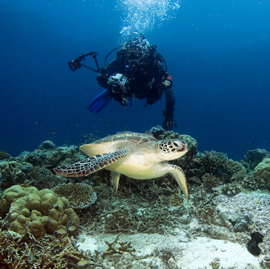Capturing an Underwater Kodak Moment
Posted: Aug 15 in Dive Blog tagged Underwater photography by Jan The vivacious colors of the reefs and fish, the ever-changing geology and plant life of the ocean floor, the way the light shines through the surface of the water— what if you could take all of the incredible things you see on your dives home with you? Regardless of how frequently we dive, all of us wish we could experience these things for longer than the fleeting glimpses allowed by our adventures underwater.
The vivacious colors of the reefs and fish, the ever-changing geology and plant life of the ocean floor, the way the light shines through the surface of the water— what if you could take all of the incredible things you see on your dives home with you? Regardless of how frequently we dive, all of us wish we could experience these things for longer than the fleeting glimpses allowed by our adventures underwater.
If you’ve gotten your dive certification in Peoria, you’ve probably already started to create some lasting memories of your underwater excursions, but plucking a fish from its underwater habitat is a bad idea no matter how fervently you want to bring it home with you. Fortunately, you can still get a great memento from your trip with underwater photography.
Of course, taking pictures underwater is not the same as it is on land. Even if you know your camera inside and out and have taken an underwater photography course, there are a few basic fundamentals you should keep in mind when snapping shots of wildlife under the sea.
- Use a strobe. Water absorbs light and can suck the color out of your underwater snapshots, turning everything blue-gray. Using a good underwater strobe will help to restore some of the color to your images while also helping to freeze movement and prevent blurring. Though these external flashes can get pricey, a good one will be an invaluable investment for any underwater photographer that will greatly enhance the quality of your pictures.
- Get ready for your close-up. Get as close to your subject as you think is necessary, then get a little closer. Taking close shots is hugely important in the world of underwater photography, as reducing the amount of water between you and your subject will make for a clearer, sharper, more colorful image. Close-ups will also help you avoid backscatter, or the tiny floating particles in the water that you may not even notice until you take a look at your pictures later.
- Shoot from below. Because wildlife is often beneath us during dives, taking pictures from above may seem like the most logical option, but getting down to eye level or lower will make for a much more interesting shot. Using an upward angle makes the view more interesting and can also help you get a better contrast between the subject in the foreground and environment in the background.
- Keep your gear in good shape. Though we may use all sorts of different electronics in our dives, the unfortunate reality is that technology and water rarely mix well. To keep your camera from getting damaged, you’ll need to be very careful during set up, ensuring that o-rings are cleaned and greased properly and that your camera’s housing will keep the water out. If you’re shooting in saltwater, you should never let it dry on your equipment—wash your camera and gear off with fresh water after every dive.
- Mind the environment. Be careful not to harm the underwater world you’re there to photograph. Respect for the environment and its denizens should be one of your top priorities. Before diving straight into the deep end with your camera, be sure you have an excellent grasp of the buoyancy skills that will help to protect you and the environment around you. You should never touch or excessively bother any form of marine life, as you might not realize the damage that even a minor touch may cause.
Of course, the most important part of underwater photography is to have fun. Don’t let yourself get too preoccupied by the technical aspects and remember that you’re there to enjoy yourself. Learn the basics first, but don’t let fretting over the perfect shot ruin your good time. Enjoy yourself!
Have you done any underwater photography? Tell us about your experiences in the comments below!
